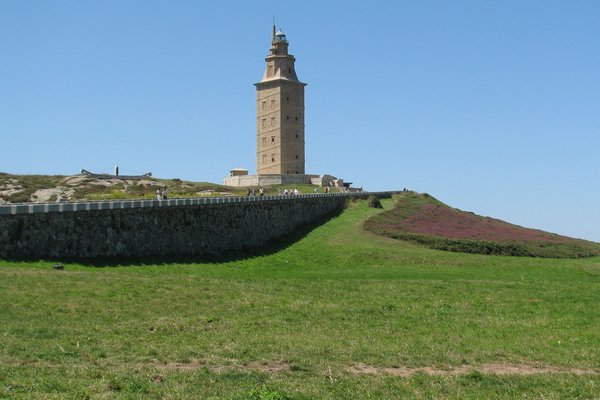Spain
Tower of Hercules
The Tower of Hercules is a lighthouse of Roman origin that is still in use.
The tower protects Western Europe’s Atlantic sea route. The Romans constructed the Farum Brigantium at the end of the 1st century AD. Its use was not continuous, during the Middle Ages it fell into disrepair and major reconstruction work was done in the 18th century. Its current form is in the neo-classical style and preserves the central core of the original Roman monument.
Community Perspective: The lighthouse has a rather remote, fine natural setting on a peninsula filled nowadays with sculptures and works of art. It can be climbed to the top.
Site Info
Official Information
- Full Name
- Tower of Hercules (ID: 1312)
- Country
- Spain
- Status
-
Inscribed 2009
Site history
History of Tower of Hercules
- 2009: Inscribed
- Inscribed
- Type
- Cultural
- Criteria
- iii
Links
- UNESCO
- whc.unesco.org
- Official
-
- torredeherculesacoruna.com — Torre de Hércules
All Links
UNESCO.org
- whc.unesco.org — whc.unesco.org/
Official Website
- torredeherculesacoruna.com — Torre de Hércules
Community Information
- Community Category
- Archaeological site: Ancient Rome
Travel Information
Recent Connections
-
Perfect Inscriptions
2009 -
Estuary
The Tower of Hercules is "a solitary li… -
Spolia
"[S]tones of the Tower were reused in (…
Connections of Tower of Hercules
- Individual People
-
-
Sir Francis Drake
in 1589 "leads a fleet with 176 ships and 5000 men on an attack against a Coruna. 6 soldiers are stationed in the tower to defend it and they hold out for 9 days, their only source of food being birds they manage to capture" (Quote from display in the Torre's Visitor Centre)
-
- Geography
-
-
Bay of Biscay
"Located in Galicia, near Cape Finisterre, this port and its lighthouse occupy a strategic position at the entry to the Bay of Biscay, marking the last stage in the route north, before Brittany and the British Isles." (AB Ev) -
Atlantic Ocean
-
Estuary
The Tower of Hercules is "a solitary lighthouse which (...) is located on the ocean shore at a height of 57 metres above sea level close to the entry channel of the estuary, acting as maritime signalling element away from the ancient port of Brigantium which was to be found sheltered from the storms in a natural inlet inside the estuary." (Nomination file, p. 79)
-
- Trivia
-
-
Modelled after
The sculpture park has a monument to the victims of the Civil War, modelled after Stonehenge -
Depicted in Mizielinska Maps
See i.pinimg.com
-
- History
-
-
Normans
In the 9th and 10th centuries, "the attacks of the Normans and the Vikings struck fear into the coasts of the south of Europe. On various occasions, enemy squadrons disembarked on Galician soil (...). [The] Chronicle of King Alphonse III (...) alluded to a battle which took place in the year 846 close to the "Farum Brecantium" or "Bregantium" and where the Asturian king's troops succeeded in defeating the Norman hoards after having sacked and burnt their ships. This episode, however, did not represent an isolated incident but rather this type of attack is alluded to on numerous occasions, particularly in the years 854 and 866 when the Normans held the Kingdom to siege." (Nomination file, p. 91-92) -
Celtic history
One of the legends connected to the tower's origin is that of Breogán of Irish origin. "Breogán, son of Brath, was the Celtic leader that subjected the Spanish tribes. After conquering the whole territory, he founded the city of Brigantia (La Coruña) and built a tower along with it, which he named the Tower of Breogán." (Nomination file, p. 65-66) The tower was "of such a grand height that his sons could see a distant green shore from its top. The glimpse of that distant green land lured them to sail north to Ireland. According to the legend, Breogán's descendants stayed in Ireland and are the Celtic ancestors of the current Irish people."See en.wikipedia.org
-
- Architecture
-
-
Octagons
Top -
Spolia
"[S]tones of the Tower were reused in (...) new buildings (...), such as the fort of the old town, the Collegiate Church of Santa María del Campo and the church of Santiago (...). [O]ne has the feeling that the surroundings of the Roman lighthouse became a makeshift quarry from which a large number of blocks of stone of a considerable size from all four facades of the Tower, which had collapsed taking with them the access ramp to the rotunda, were extracted." (Nomination file, p. 97) "The looting of materials continued until 1557, when the Town Council banned the extraction of ashlars from the Tower, under threat of fines." (Nomination file, p. 177) -
Neoclassical architecture
Restoration -
Sites from antiquity with identified architects
"(...) it is the only Roman lighthouse of which the name of the architect and engineer who built it is known: Gaius Sevius Lupus, who immortalised his name by leaving it engraved on a commemorative inscription at the foot of his work". (Executive Summary, p. V)
-
- World Heritage Process
-
-
Perfect Inscriptions
2009 -
WHC locations
Seville (2009) -
Inscribed on a single criterion only
iii. to bear a unique or at least exceptional testimony to a cultural tradition or to a civilization which is living or which has disappeared -
Single Monuments
-
- Religion and Belief
-
-
Legends and Folk Myths
"Numerous legends surround the Tower's history, from the Middle Ages to the 19th century. They attempt to explain in mythical and popular terms the Tower's origins and its construction, regardless of any historical or archaeological understanding. There are three main families of legends: the legend of Breogán in the Celtic-Irish tradition, the Greco-Roman legend of Hercules, the demigod of mythical strength who gave the Tower its contemporary name, and the tale of Trecenzonio halfway between the former two legends." (Ab Ev) -
Hercules
Wiki: "According to a myth that blends Celtic and Greco-Roman elements, the hero Hercules slew the giant tyrant Geryon after three days and three nights of continuous battle. Hercules then - in a Celtic gesture - buried the head of Geryon with his weapons and ordered that a city be built on the site. The lighthouse atop a skull and crossbones representing the buried head of Hercules' slain enemy appears in the coat-of-arms of the city of Corunna."
-
- Human Activity
-
-
Petroglyphs
Monte dos Bicos
-
- Constructions
-
-
Cemeteries
"There is a Muslim cemetery at the extremity of the property, with ties to the Spanish Civil War in the 20th century" (AB) -
Lighthouses
"The Tower of Hercules has served as a lighthouse and landmark at the entrance of La Coruña harbour in north-western Spain since the late 1st century A.D. when the Romans built the Farum Brigantium." (Official description) -
Cultural sites connected to Cliffs
The large urban park where the Tower is situated used to be military zones and was "recovered by the City Council of A Coruña in order to create an extensive green zone. (...) The value of this reclaimed area's landscape is immense; a coastline of great natural beauty, with sheer cliffs dropping down to the sea, forming a never-ending display of inlets and headlands upon which the waves of the Atlantic crash." (Nomination file, p. 14) The lighthouses "that were erected on Atlantic shores were built on coastal cliffs in particularly dangerous areas in order to direct ships away from the shallows, which could threaten their wooden hulls." (Nomination file, p. 137) -
Prison
Old Provincial Prison is part of the inscribed area
-
- Timeline
-
-
Built in the 1st century
"Under the name of Farum Brigantium, the Tower was probably erected in the 1st century CE" (AB ev)
-
- WHS Hotspots
- Science and Technology
-
-
International Exhibitions
The "image of renovation, change and progress was what influenced the Government of Spain to send a model of the Tower of Hercules lighthouse to the Universal Exhibition in Paris in 1869 as an example of the new engineering projects that were being undertaken in the country. This international forum was chosen to display the new value that had been conferred upon the Tower of Hercules, not only on a regional and national level, but also internationally. This task of publicising the monument was completed by the presentation of the same model at the Universal Exhibition of Vienna in 1873." (Executive Summary, p. VI)
-
News
No news.
Recent Visitors
Visitors of Tower of Hercules
- Adam Hancock
- Adolfo
- Adrian Turtschi
- Alberto Rodriguez Gutierrez
- Alexander Barabanov
- Alexander Lehmann
- alicemears
- Alikander99
- A. Mehmet Haksever
- Ammon Watkins
- Ana Lozano
- Angela Vandyck
- Anna Wludarska
- Antonio J.
- Argo
- BaziFettehenne
- Bill Maurmann
- Bin
- Bram de Bruin
- Catoplayer
- Cezar Grozavu
- Cheryl
- Christian Wagner
- Christravelblog
- Claire Bradshaw
- Clyde
- Corinne Vail
- CugelVance
- Daniela Hohmann
- Daniel Chazad
- Dan Pettigrew
- David Aaronson
- David Berlanda
- Dimitar Krastev
- Dimitrios Polychronopoulos
- Dorejd
- Echwel
- Elaine McArdle
- Els Slots
- Emilia
- Ertai
- Eva Kisgyorgy
- Evgenii
- fabi-ddorf
- Fan Yibo
- Farinelli
- Feldhase
- Femke Roos
- Filip Murlak
- FS
- GeorgeIng61
- Gernot
- Harry Mitsidis
- Hubert
- Iain Jackson
- Ian Cade
- Ingemar Eriksson
- Ivan Rucek
- Jakob F.
- janis
- Jan-Willem
- Jarek Pokrzywnicki
- Jasam
- Javier Coro
- Jay T
- Jeanne OGrady
- Jens
- Jezza
- João Aender
- Joel on the Road
- Jonas Kremer
- Jonas Martinsson
- Jon Eshuijs
- Joyce van Soest
- Jurre
- KarenBMoore
- Karito Vies
- Kbecq
- Knut
- krtek
- Krzysztof B
- Kurt Lauer
- Lado Joel
- Laffingleigh
- Lara Adler
- LaVale
- lichia
- Loic Pedras
- Luboang
- Lucas Del Puppo
- Ludvan
- Luis Filipe Gaspar
- Maciej Gil
- manuel011197
- Martin
- Marty
- Mathijs
- MAURO PODDA PANI
- MaYumin
- MH
- MichaelH
- Michael Novins
- Miguel Marquez
- Mikan22
- Mikko
- Mikko Syrjä
- Milan Jirasek
- Msarmiento1979
- nan
- napalm
- Patrik
- Paul Schofield
- Persian Globetrotter
- Petteri
- Philipp Leu
- Philipp Peterer
- Piotr Wasil
- Porcho
- Rafabram
- Randi Thomsen
- Reisedachs
- Roger Ourset
- Roman Bruehwiler
- Samy G
- sandersx2
- Sandmann15
- Schnitzel
- scubarrie
- SDMArado
- Shandos Cleaver
- Shijie ZHU
- Solivagant
- Stanimir
- Stanislaw Warwas
- stephanvermeulen
- Svein Elias
- Szucs Tamas
- Tamara Ratz
- Taotao Chen
- Tarquinio_Superbo
- Tcchang0825
- Tevity
- Thomas Buechler
- Thomas van der Walt
- Tim Allen
- travellingcat
- triath
- Truls Brekke
- usagi1974
- Vanessa Buechler
- Van Hung
- Viaje al Patrimonio
- voyager
- Walter
- Waxwing
- Wojciech Fedoruk
- Xander Huang
- Xiong Wei
- Xiquinho Silva
- Yongcheng Liu
- Zoë Sheng
- Zos M
Community Reviews
Show full reviews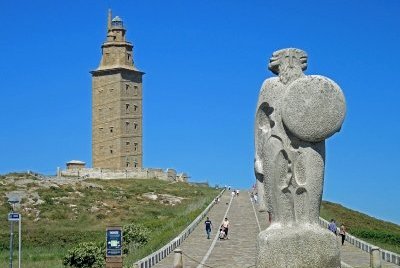
A statue greets visitors to the Tower of Hercules, but the statue is not the Greek or Roman hero. No, it is instead a Celtic king, a legend named Breogán, from a foreign land far from Galicia in northwest Spain. According to stories, after wandering the earth, the king settles in Iberia and and builds a city named Brigantia and a tower from which he espies the emerald shores of Ireland. Breogán may not have ever existed, but the Galicians have Celtic ties to Hibernia in their history, as has been confirmed by DNA testing linking the Irish with the north coast of Spain. And that tower that made its way into the stories? It may very well be the Tower of Hercules.
I visited the Tower of Hercules on a delightfully sunny day in May 2019. The tower stands on a hill at the end of a peninsula on the north side of A Coruña, and was an easy destination to aim for as I drove along the coast. The parking lot at the end of the peninsula was rather convenient, with the ticket office, complete with a small museum, nearby. I visited on a weekday in the summer, and was able to procure a ticket with the next earliest entry time; I'm not sure if it is busier on weekends, but I was glad to not have a long wait. Even if I did have to wait, though, the peninsula had plenty of sculptures and works of …
Keep reading 0 comments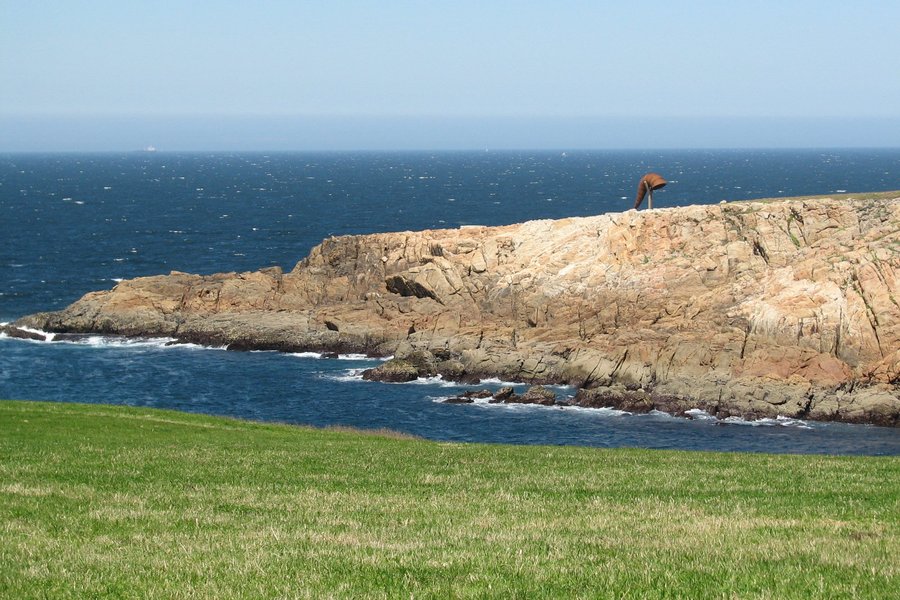
Probably our shortest World Heritage site visit so far, even shorter than the plague column in Olomouc! The tower itself is very impressive, though most of what you can see isn't the original Roman construction. We had hoped to climb the lighthouse and have a nice view back across to La Coruna and the harbour, but as you'll see in the video below it was unbelievably windy and the tower was closed! All there was for it was to walk around the tower a couple of times, admire it from each direction, and then depart.
Keep reading 0 comments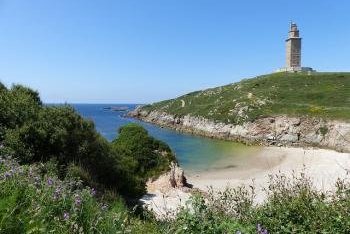
I visited this WHS in May 2016. The Tower of Hercules is one of the highlights of Galicia and A Coruna's landmark. Yet, its geographic position being rather remote is such that it does not attract so many foreign tourists. In fact there are no bars, restaurants, souvenir shops or hotels in the immediate vicinity of the tower. The surrounding sculpture park (containing also minor petroglyphs) is also inscribed, most probably as a huge buffer zone to protect the site from urban sprawl. The natural setting is indeed beautiful with a lovely sandy beach, rocky cliffs and birdwatching trails. I was quite lucky as I visited on a lovely sunny day with only a cool pleasant breeze. The walk towards the tower does NOT offer the best views. Instead if you visit in the afternoon, head left from the small visitor centre away from the tower and you'll enjoy magnificent panoramic views of the tower, the sandy beach and the rocky cliffs. I visited on a Monday so the entrance to the tower was free. The Roman foundations can be viewed as soon as you enter the tower. The stairs are quite wide and sturdy so I'd really recommend the extra effort. The ventilation is excellent too. The view from the top is quite something and you'll be able to appreciate why the sculpture park was added (just look at the urban sprawl of A Coruna and then compare it to the beautiful natural setting surrounding the tower!). I visited …
Keep reading 0 comments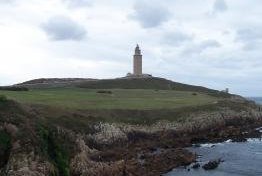
An early finish to my Camino gave me a day spare to venture north to A Coruña and visit the windiest WHS so far.
The lighthouse is quite impressive and can be seen from a fair distance away back on the Western beach in A Coruña. It is a very fine looking tower, but it is not really that 'Roman' and has not even been continually used as Lighthouse for the entirety of its life. However there are some Roman remains buried underneath it and I got a view of these when I went inside. They were about as interesting as a selection of dimly lit rocks can be. There were repairs going on to the Tower so I wasn't able to climb it. I then headed on out to see the surrounding additions to the inscription on the peninsula. It was a little bit of a way to get to the furthest points so I took the opportunity to hire a Segway (second time at a WHS this year) and head of to the extremities. This proved to be a very enjoyable way of getting to see some of the abstract sculptures and the small Muslim cemetery. Quite what these have to do with the lighthouse I am not sure, however it does mean that this rather lovely part of the coastline is left free of development, and I found it an exceptionally rewarding place to be blown around by the increasingly strong winds.
If you ever really want …
Keep reading 0 comments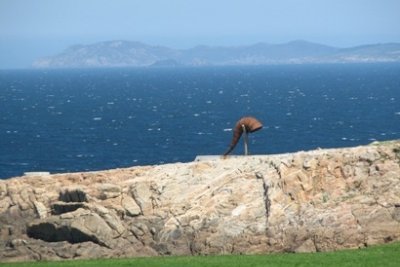
As I'm the first one to review this 2009 addition to the List, let's start with the practical details. The Tower is located at the tip of a peninsula in the north of the city of La Coruña (that's A Coruña in Galician). It is well signposted from there too. Although it's only a couple of kilometres from the city centre, I'd recommend not to walk from there (quite boring) but go to the site directly. There's a huge parking lot on the peninsula, but not really anything else besides toilets and an ice cream stall. Hundreds of other visitors were present when I visited the site on a Tuesday in August. It was already a popular destination before it became a WHS (120,000 visitors in 2006), and I guess now these numbers will become even higher.
The Tower / Lighthouse can be climbed all to the top. The entrance costs 2.5 EUR. I didn't really want to go up in my current condition, but buying the ticket is the only way to see some of the interiors. Fortunately, there are several points at which you can turn around or exit. The climb starts at the base, where the Roman foundations can be seen. The tower is called a 'Roman Lighthouse', but most of what you see dates from the 18th century. The Roman lighthouse (or what's left of that) is 'inside' the bigger current lighthouse (like a mathruska doll). ICOMOS applauded its 'functional integrity' more than its Roman …
Keep reading 0 comments
